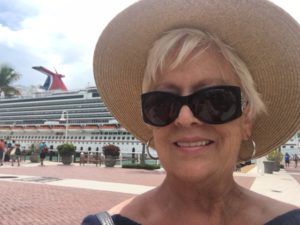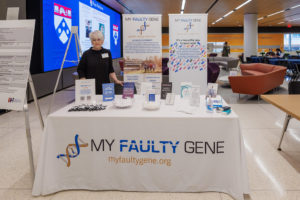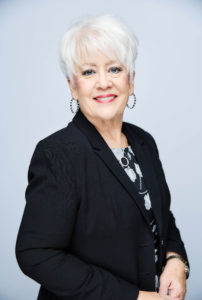My Map & My Flashlight: How Genetic Testing Saved My life
By Kathy Baker
A friend recently asked me to meet a woman she knew from an online hereditary cancer group. Jennifer was interested in learning more about patient advocacy, and I agreed to a virtual meeting. As a hereditary cancer survivor and long-time patient advocate, I am passionate about talking to others whose lives have been impacted by a “faulty gene”—just as mine has been.
Not long into our chat, I knew Jennifer was a kindred spirit. I found the metaphor she used when discussing the impact of discovering her own pathogenic gene mutation to be especially insightful:
“I’ve been given a map and a flashlight.”
What a great visual for describing how knowing your hereditary cancer risks can put you on a path to potentially reducing those risks!
My own hereditary cancer story begins with my Stage 2B breast cancer diagnosis in 2000. Although my oncologist suggested genetic testing shortly after my diagnosis because of my family’s history of various cancers, testing was relatively new at that time. (The “Angelina Jolie effect” which resulted in a huge uptick in genetic testing wouldn’t begin for another 13 years.) After my own diagnosis, lumpectomy, chemo and radiation, I honestly believed my cancer was “one and done”—so I saw no need for genetic testing. In fact, had my mom and I not shared the same oncologist, I likely would have discontinued my annual oncology checkups after a few years with no evidence of disease.

In 2009, an important study was shared with my oncologist by Myriad Genetics. The Metcalfe study found that women with a history of early breast cancer (Stage 0 to Stage 2B) who tested positive for a BRCA1 mutation had a 1 in 3 risk of going on to get ovarian cancer. For women with a BRCA2 mutation, the risk was 1 in 7.
Armed with this new information and concerned that my family looked like a poster family for a BRCA mutation, at my next checkup my oncologist finally convinced both me and my sister (also a breast cancer survivor) to undergo genetic testing. We both tested positive for a BRCA1 mutation.
Because my sister had already had both a double mastectomy and a complete hysterectomy, learning of her mutation didn’t result in any risk-reducing surgical recommendations. However, since I still had my breasts and my ovaries, it was time to make use of my new map and flashlight and follow the recommended path of risk-reducing surgeries in order to avoid another cancer diagnosis.
Four months after learning of my BRCA1 mutation, my mom passed from cancer. Before she died, I promised her I would go forward with my “risk-reducing” surgeries.
Wanting every reminder of cancer behind me as quickly as possible (and still clinging to my “one and done” mentality of the previous nine years), I found three surgeons who agreed to work together to perform my surgeries as “piggy-backed” surgeries. Two months later, I had a double mastectomy, followed by breast reconstruction with implants, followed by a total hysterectomy with bilateral salpingo-oophorectomy. It was a long 10-hour surgery.
Imagine our surprise when the third surgery unexpectedly revealed I already had Stage 1 ovarian cancer. I was one of the 1 in 3 from the Metcalfe study! With the pathologist noting in his report that my tumor was less than 0.25 mm from spreading, it was clear that had I waited any longer, my outcome would have been very different. But because adjuvant chemotherapy was successful in removing any stray cancer cells, I have now been cancer-free for 14 years.
Not long after my breast cancer diagnosis, I had discovered my passion in advocating for others with cancer. I chaired numerous events for the American Cancer Society, was named an ACS Hero of Hope, served on councils and cancer boards, and even put on my legislative advocacy hat to work with ACS-CAN to help pass important cancer-related legislation both in my own state and nationally.
ACTING ON ADVOCACY
After learning of my BRCA1 mutation proved lifesaving for me, I began looking for patient advocacy organizations working specifically in the hereditary cancer space. I quickly found F.O.R.C.E.—a well-respected and long-established group that was already successfully providing both reliable information about hereditary cancer and access to support groups.

Something I was not finding was a nonprofit organization filling the gap for underrepresented, uninsured, and underinsured individuals in need of help to fund their access to genetic counseling and genetic testing. In early 2020, I founded My Faulty Gene to fill that gap.
My Faulty Gene is a national nonprofit organization serving as a resource both to people reaching out to us directly and to providers asking for our assistance when their patients aren’t qualifying for genetic counseling and genetic testing under their insurance plans. If there is a need for genetic testing, we do our best to meet that need. We have funded counseling and testing for hundreds of people across the country over the past few years, with many life-saving results.
Many people think that genetic testing is cost prohibitive—especially for individuals without health insurance. For self-pay patients, however, the cost is usually around $250. Knowing that even a reduced price of $250 can put testing out of reach for many, we provide funding for genetic counseling and genetic testing as funds are available, and additionally work on appeals of insurance denials.
One of our most important educational efforts has been the creation of our recently released video series of short and compelling stories of individuals with various hereditary cancer gene mutations. We believe our Family Gene Share videos will be especially impactful in helping convince family members to undergo their own testing once a mutation has been identified in a family member. If you have a known mutation, I encourage you to watch Stacey’s BRCA1 story and Mark’s BRCA2 story to learn about the importance of sharing that information with your family members.
If you have had breast cancer and have never had genetic testing, or if you had testing that was limited only to BRCA testing before additional gene mutations related to breast cancer were discovered, please talk to your doctor about testing. You might learn you are also in need of a map and a flashlight.

Kathy is the executive director of My Faulty Gene and Pink Fund’s newest guest blogger.
